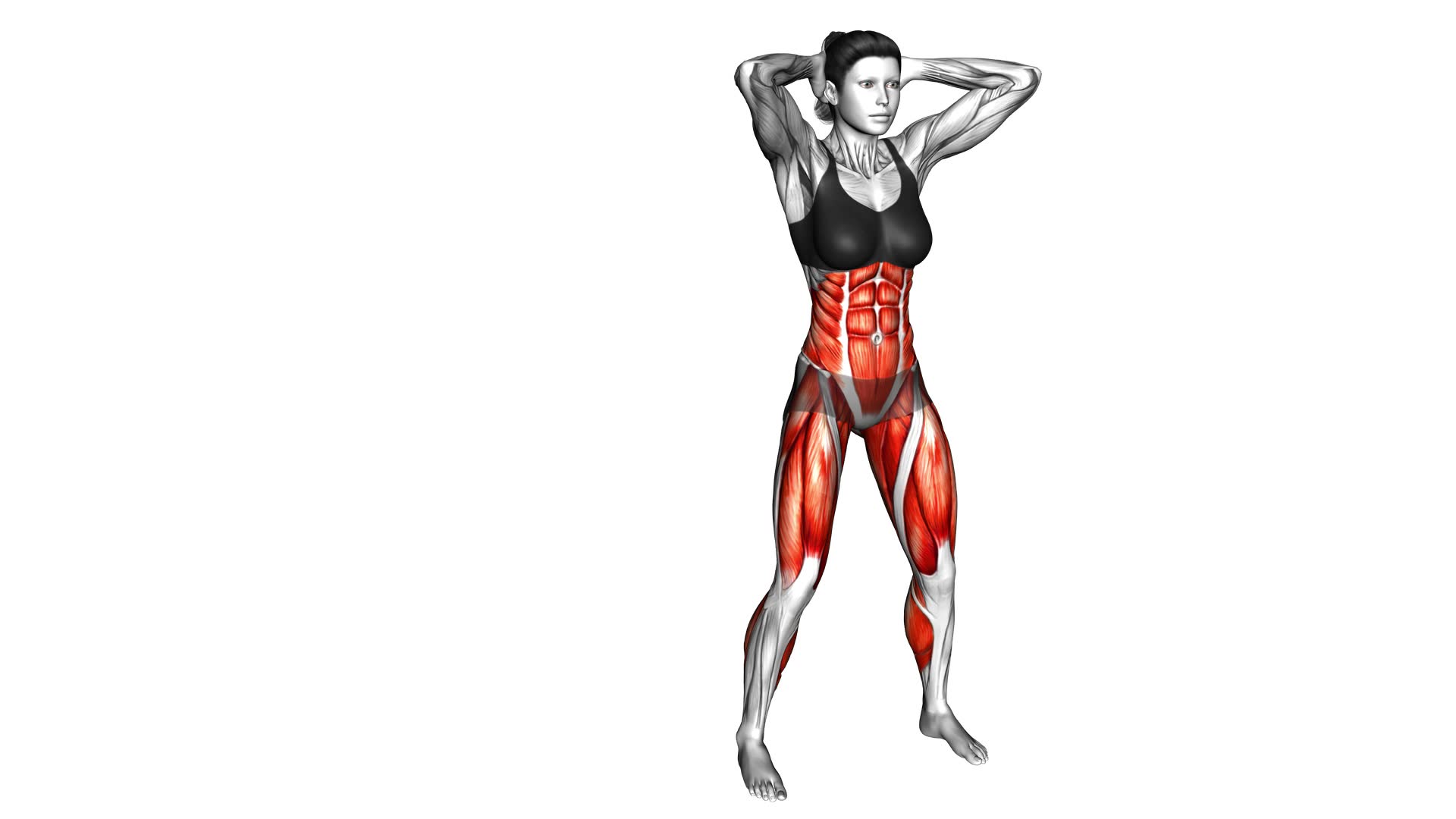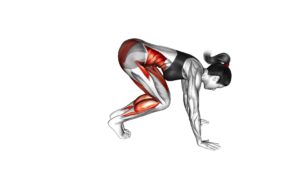Forward Wide Walk (female) – Video Exercise Guide & Tips

Get ready to elevate your workout with the Forward Wide Walk! This video exercise guide is specifically designed for females, providing you with a detailed step-by-step demonstration and valuable tips to perfect your form.
Watch This Exercise Video
Discover the benefits of this exercise, learn the equipment you'll need, and explore modifications for different fitness levels. Avoid common mistakes and maximize the effectiveness of your workout.
It's time to take your fitness journey to the next level with the Forward Wide Walk!
Key Takeaways
- The Forward Wide Walk targets multiple muscle groups, strengthens and tones muscles, improves hip mobility, and can be modified for different fitness levels.
- Proper form and technique for the exercise include starting with feet shoulder-width apart, maintaining tall posture, and bringing the other foot forward in a wide step.
- No additional equipment is needed for the Forward Wide Walk, making it a versatile exercise that can be done anywhere.
- To maximize the effectiveness of the exercise, maintain slow and controlled movements, engage the core, and track progress over time.
Benefits of the Forward Wide Walk
Experience the numerous benefits of the Forward Wide Walk, a simple yet effective exercise that targets multiple muscle groups.
This exercise offers a variety of benefits that can enhance your overall fitness and well-being.
One of the main benefits is the engagement of multiple muscle groups. As you perform the Forward Wide Walk, your glutes, quadriceps, hamstrings, and calves are all activated. This helps to strengthen and tone these muscles, leading to improved stability and balance.
Another benefit of the Forward Wide Walk is its ability to improve hip mobility. By moving laterally and in a wide stance, you're working on hip abduction and external rotation. This can be particularly beneficial for athletes and individuals who participate in activities that require lateral movements, such as basketball or tennis.
Furthermore, the Forward Wide Walk can also be modified to increase the challenge and target specific muscle groups. You can add resistance bands around your ankles or hold dumbbells to increase the intensity. Additionally, you can perform the exercise on an incline or decline surface to target different areas of your lower body.
In conclusion, the Forward Wide Walk is a versatile exercise that offers numerous benefits. By incorporating variations and modifications, you can customize the exercise to suit your fitness level and goals.
Proper Form and Technique for the Exercise
To properly execute the Forward Wide Walk, ensure that your form and technique are correct. Proper form is essential not only for maximizing the benefits of this exercise, but also for preventing injuries. Start by standing with your feet shoulder-width apart and your toes pointing slightly outward. Engage your core and maintain a tall posture throughout the exercise.
As you take a step forward with your right foot, make sure to step out wider than your shoulder width. Keep your weight on your heels and lower your body into a squat position, bending at the knees and hips. Your knees should be in line with your toes, and your thighs should be parallel to the ground.
Next, bring your left foot forward, stepping out to the side and wider than your shoulder width. Again, lower your body into a squat position. Continue this wide walking motion, making sure to maintain proper form and technique.
The Forward Wide Walk is an excellent exercise for improving balance and strengthening the glutes. By stepping out wider than your shoulder width, you engage the glute muscles more effectively. This exercise also challenges your balance and stability, helping to improve coordination and control.
Remember to breathe throughout the exercise and to listen to your body. If you experience any pain or discomfort, modify the exercise or consult with a fitness professional.
Equipment Needed for the Forward Wide Walk
To perform the Forward Wide Walk, you won't need any additional equipment. This exercise can be done without the use of any specialized equipment or props. All you need is a clear space to move in and comfortable workout attire. The purpose of the Forward Wide Walk is to engage your glutes, hips, and thighs, so it's important to focus on proper execution rather than relying on equipment.
When performing the Forward Wide Walk, start by standing with your feet shoulder-width apart. Take a wide step forward with your right foot, keeping your toes pointed forward. As you step forward, shift your weight onto your right foot and lower your body into a squat position. Push off with your right foot and bring your left foot forward, repeating the same movement on the opposite side. Continue this forward walking motion, maintaining a wide step and squatting position with each step.
Modifications and Variations for Different Fitness Levels
How can you modify and vary the Forward Wide Walk exercise based on your fitness level?
There are several progression options you can consider to challenge yourself and target different muscle groups.
If you're a beginner or have limited mobility, you can start by performing the Forward Wide Walk without any added resistance. Focus on maintaining proper form and control throughout the movement. As you become more comfortable, you can gradually increase the intensity by using ankle weights or resistance bands. This will engage your leg muscles more and provide a greater challenge for your lower body.
For intermediate fitness levels, you can try incorporating variations to target specific muscle groups. To increase the activation of your glutes and outer thighs, you can perform the exercise on a resistance band or step platform. This will add extra resistance and help strengthen these areas. Another progression option is to perform the exercise on an incline or decline, which will challenge your core stability and engage your upper body muscles.
Advanced fitness levels can add more intensity by using heavier resistance bands or weights. You can also try performing the exercise at a faster pace or incorporating other dynamic movements such as lunges or jumps. These variations will increase the overall difficulty and provide a more challenging workout.
Remember to always listen to your body and progress at a pace that feels comfortable for you. It's important to maintain proper form and avoid overexertion to prevent any injuries.
Common Mistakes to Avoid While Performing the Forward Wide Walk
Avoiding common mistakes is important when performing the Forward Wide Walk exercise. To ensure proper alignment and maximize the effectiveness of the exercise, it's essential to be aware of common errors that may occur.
One common mistake isn't maintaining proper alignment throughout the exercise. It's important to keep your back straight, shoulders down and relaxed, and core engaged. Avoid arching your back or allowing your shoulders to hunch forward, as this can lead to strain or injury.
Another common error is taking too large of a step. While it's called a 'wide' walk, it's crucial to find a comfortable stride length that allows you to maintain proper form. Taking overly large steps can cause imbalance and compromise the stability of the exercise.
A third common mistake is rushing through the movement. The Forward Wide Walk should be performed with control and intention. Take your time and focus on engaging the muscles in your legs and core. Rushing through the exercise can result in sloppy form and reduced effectiveness.
Tips for Maximizing the Effectiveness of the Exercise
Maximize the effectiveness of the exercise by maintaining proper form and focusing on engaging your muscles. Here are some tips to help you get the most out of your Forward Wide Walk:
- Common Misconceptions:
- Avoid the misconception of thinking that speed is more important than form. It's crucial to maintain a slow and controlled movement throughout the exercise to ensure proper muscle engagement and prevent injuries.
- Another common mistake isn't keeping your core engaged. Your core muscles play a vital role in stabilizing your body during the exercise, so make sure to activate them by pulling your belly button towards your spine.
- Progress Tracking:
- To maximize the effectiveness of the exercise, track your progress over time. Keep a record of the number of steps you take, the distance covered, or the duration of your workout. This will help you set goals and challenge yourself to improve.
- Additionally, consider using a fitness tracker or an app that can monitor your heart rate and calories burned during the exercise. This information can give you a better understanding of your effort and help you adjust your intensity for optimal results.
By following these tips and avoiding common misconceptions, you can ensure that you're getting the most out of your Forward Wide Walk and making progress towards your fitness goals.
Keep pushing yourself, and don't forget to listen to your body for any signs of fatigue or discomfort.
Frequently Asked Questions
How Many Sets and Repetitions Should I Do for the Forward Wide Walk Exercise?
To determine the number of sets and repetitions for the forward wide walk exercise, consider your fitness level and goals.
Start with 2-3 sets of 10-15 repetitions and gradually increase the intensity as you get stronger.
You can also try variations like adding resistance bands or modifying the width of your steps.
Remember to listen to your body and adjust the workout accordingly.
Can I Perform the Forward Wide Walk Exercise if I Have Knee or Hip Pain?
Yes, you can still perform the forward wide walk exercise if you have knee or hip pain. However, it's important to listen to your body and modify the exercise as needed.
If you experience discomfort, try reducing the range of motion or using a resistance band for added support.
Alternatively, there are other exercises you can do that are gentle on the knees and hips, such as standing leg lifts or seated leg extensions.
Is It Better to Perform the Forward Wide Walk Exercise on a Hard Surface or on a Mat?
When deciding whether to perform the forward wide walk exercise on a hard surface or on a mat, consider the impact on your joints. A hard surface may provide more stability and resistance, while a mat can offer cushioning and reduce strain on your knees and hips.
Experiment with both options to see what feels more comfortable for you. Remember to incorporate a warm-up routine, try variations, and add resistance to maximize the benefits of this exercise.
Can the Forward Wide Walk Exercise Help With Improving Balance and Stability?
The forward wide walk exercise can definitely help you improve your balance and stability. By engaging your core and activating the muscles in your legs and hips, this exercise challenges your coordination and strengthens the muscles responsible for maintaining stability.
Incorporating lateral exercises like the forward wide walk into your routine can provide numerous benefits, such as improved balance, enhanced proprioception, and increased stability in everyday activities.
How Long Should I Rest Between Sets When Doing the Forward Wide Walk Exercise?
When doing the forward wide walk exercise, it's important to consider the rest periods between sets. In order to optimize the benefits of this exercise, it's recommended to rest for about 30-60 seconds between each set.
This allows your muscles to recover and maintain proper form throughout the workout. By giving yourself adequate rest periods, you can ensure that you're getting the most out of the forward wide walk exercise and improving your balance and stability effectively.
Conclusion
In conclusion, the Forward Wide Walk is a highly effective exercise that offers numerous benefits for women.
By maintaining proper form and technique, using the necessary equipment, and making modifications based on fitness levels, individuals can maximize the effectiveness of this exercise.
It's important to avoid common mistakes and follow the provided tips to ensure optimal results.
Incorporating the Forward Wide Walk into your fitness routine can help improve strength, stability, and overall fitness.

Author
Years ago, the spark of my life’s passion ignited in my mind the moment I stepped into the local gym for the first time. The inaugural bead of perspiration, the initial endeavor, the very first surge of endorphins, and a sense of pride that washed over me post-workout marked the beginning of my deep-seated interest in strength sports, fitness, and sports nutrition. This very curiosity blossomed rapidly into a profound fascination, propelling me to earn a Master’s degree in Physical Education from the Academy of Physical Education in Krakow, followed by a Sports Manager diploma from the Jagiellonian University. My journey of growth led me to gain more specialized qualifications, such as being a certified personal trainer with a focus on sports dietetics, a lifeguard, and an instructor for wellness and corrective gymnastics. Theoretical knowledge paired seamlessly with practical experience, reinforcing my belief that the transformation of individuals under my guidance was also a reflection of my personal growth. This belief holds true even today. Each day, I strive to push the boundaries and explore new realms. These realms gently elevate me to greater heights. The unique combination of passion for my field and the continuous quest for growth fuels my drive to break new ground.



